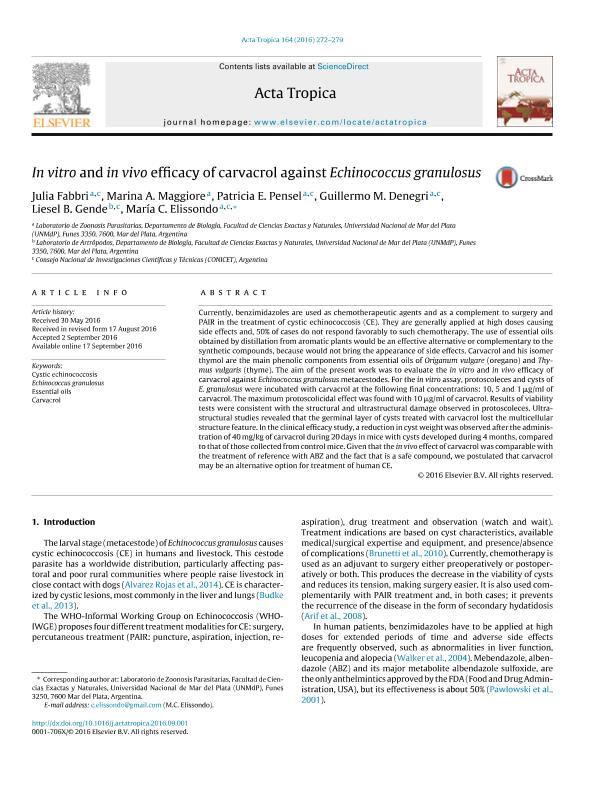Mostrar el registro sencillo del ítem
dc.contributor.author
Fabbri, Julia

dc.contributor.author
Maggiore, Marina Alejandra

dc.contributor.author
Pensel, Patricia Eugenia

dc.contributor.author
Denegri, Guillermo Maria

dc.contributor.author
Gende, Liesel Brenda

dc.contributor.author
Elissondo, María Celina

dc.date.available
2022-12-01T12:10:57Z
dc.date.issued
2016-12
dc.identifier.citation
Fabbri, Julia; Maggiore, Marina Alejandra; Pensel, Patricia Eugenia; Denegri, Guillermo Maria; Gende, Liesel Brenda; et al.; In vitro and in vivo efficacy of carvacrol against Echinococcus granulosus; Elsevier Science; Acta Tropica; 164; 12-2016; 272-279
dc.identifier.issn
0001-706X
dc.identifier.uri
http://hdl.handle.net/11336/179718
dc.description.abstract
Currently, benzimidazoles are used as chemotherapeutic agents and as a complement to surgery and PAIR in the treatment of cystic echinococcosis (CE). They are generally applied at high doses causing side effects and, 50% of cases do not respond favorably to such chemotherapy. The use of essential oils obtained by distillation from aromatic plants would be an effective alternative or complementary to the synthetic compounds, because would not bring the appearance of side effects. Carvacrol and his isomer thymol are the main phenolic components from essential oils of Origanum vulgare (oregano) and Thymus vulgaris (thyme). The aim of the present work was to evaluate the in vitro and in vivo efficacy of carvacrol against Echinococcus granulosus metacestodes. For the in vitro assay, protoscoleces and cysts of E. granulosus were incubated with carvacrol at the following final concentrations: 10, 5 and 1 μg/ml of carvacrol. The maximum protoscolicidal effect was found with 10 μg/ml of carvacrol. Results of viability tests were consistent with the structural and ultrastructural damage observed in protoscoleces. Ultrastructural studies revealed that the germinal layer of cysts treated with carvacrol lost the multicellular structure feature. In the clinical efficacy study, a reduction in cyst weight was observed after the administration of 40 mg/kg of carvacrol during 20 days in mice with cysts developed during 4 months, compared to that of those collected from control mice. Given that the in vivo effect of carvacrol was comparable with the treatment of reference with ABZ and the fact that is a safe compound, we postulated that carvacrol may be an alternative option for treatment of human CE.
dc.format
application/pdf
dc.language.iso
eng
dc.publisher
Elsevier Science

dc.rights
info:eu-repo/semantics/openAccess
dc.rights.uri
https://creativecommons.org/licenses/by-nc-sa/2.5/ar/
dc.subject
CARVACROL
dc.subject
CYSTIC ECHINOCOCCOSIS
dc.subject
ECHINOCOCCUS GRANULOSUS
dc.subject
ESSENTIAL OILS
dc.subject.classification
Otras Ciencias Biológicas

dc.subject.classification
Ciencias Biológicas

dc.subject.classification
CIENCIAS NATURALES Y EXACTAS

dc.title
In vitro and in vivo efficacy of carvacrol against Echinococcus granulosus
dc.type
info:eu-repo/semantics/article
dc.type
info:ar-repo/semantics/artículo
dc.type
info:eu-repo/semantics/publishedVersion
dc.date.updated
2022-12-01T11:26:59Z
dc.journal.volume
164
dc.journal.pagination
272-279
dc.journal.pais
Países Bajos

dc.journal.ciudad
Amsterdam
dc.description.fil
Fil: Fabbri, Julia. Universidad Nacional de Mar del Plata. Facultad de Ciencias Exactas y Naturales. Departamento de Biología. Laboratorio de Zoonosis Parasitarias; Argentina. Consejo Nacional de Investigaciones Científicas y Técnicas. Centro Científico Tecnológico Conicet - Mar del Plata; Argentina
dc.description.fil
Fil: Maggiore, Marina Alejandra. Universidad Nacional de Mar del Plata. Facultad de Ciencias Exactas y Naturales. Departamento de Biología. Laboratorio de Zoonosis Parasitarias; Argentina. Consejo Nacional de Investigaciones Científicas y Técnicas. Centro Científico Tecnológico Conicet - Mar del Plata; Argentina
dc.description.fil
Fil: Pensel, Patricia Eugenia. Universidad Nacional de Mar del Plata. Facultad de Ciencias Exactas y Naturales. Departamento de Biología. Laboratorio de Zoonosis Parasitarias; Argentina. Consejo Nacional de Investigaciones Científicas y Técnicas. Centro Científico Tecnológico Conicet - Mar del Plata; Argentina
dc.description.fil
Fil: Denegri, Guillermo Maria. Universidad Nacional de Mar del Plata. Facultad de Ciencias Exactas y Naturales. Departamento de Biología. Laboratorio de Zoonosis Parasitarias; Argentina. Consejo Nacional de Investigaciones Científicas y Técnicas. Centro Científico Tecnológico Conicet - Mar del Plata; Argentina
dc.description.fil
Fil: Gende, Liesel Brenda. Universidad Nacional de Mar del Plata. Facultad de Ciencias Exactas y Naturales. Departamento de Biología. Laboratorio de Artrópodos; Argentina. Consejo Nacional de Investigaciones Científicas y Técnicas. Centro Científico Tecnológico Conicet - Mar del Plata; Argentina
dc.description.fil
Fil: Elissondo, María Celina. Universidad Nacional de Mar del Plata. Facultad de Ciencias Exactas y Naturales. Departamento de Biología. Laboratorio de Zoonosis Parasitarias; Argentina. Consejo Nacional de Investigaciones Científicas y Técnicas. Centro Científico Tecnológico Conicet - Mar del Plata; Argentina
dc.journal.title
Acta Tropica

dc.relation.alternativeid
info:eu-repo/semantics/altIdentifier/url/https://www.sciencedirect.com/science/article/pii/S0001706X1630345X
dc.relation.alternativeid
info:eu-repo/semantics/altIdentifier/doi/http://dx.doi.org/10.1016/j.actatropica.2016.09.001
Archivos asociados
